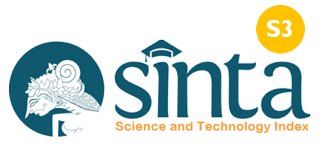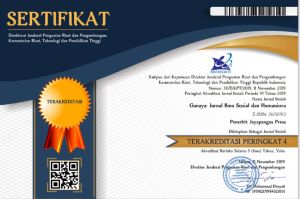Analisis Miskonsepsi IPA Materi Fotosintesis Ditinjau dari Perspektif Siswa
DOI:
https://doi.org/10.37329/cetta.v8i1.3868Keywords:
Photosynthesis, science, misconceptions, elementary school, three tier diagnostic testAbstract
The research was conducted to analyze the existence of science misconceptions in photosynthesis material through students' perspectives. Misconceptions in students are misunderstandings of concepts understood by students that can affect student understanding in learning. Photosynthesis material is complex material so that misconceptions often occur in students. The research was conducted on 20 grade VI elementary school students using a three tier diagnostic test to measure students' understanding of the material concept. This research is a qualitative research with a descriptive approach. Data collection techniques were carried out with tests, interviews, observations, and documentation. Data analysis techniques in this study are data reduction, data presentation, and conclusions. The results of the study based on the analysis of the three tier diagnostic test showed that 17.14% of students were in the category of understanding the concept, 44.29% of students experienced misconceptions with positive misconceptions of 7.14%, negative misconceptions of 12.86%, and pure misconceptions of 24.29%, other categories were guessing as many as 12.86% of students, and did not understand the concept as many as 25.71%. These results show that there are students who have identified misconceptions in photosynthesis material with moderate categories. The highest misconception occurred in the material coverage of the time of photosynthesis which was 90% with a high category and the lowest misconception occurred in the material coverage of the purpose of photosynthesis which was 10% with a low category. The results of data analysis based on student perspectives, misconceptions occur due to student preconceptions, teacher explanations, and other teaching materials. The conclusion based on the data obtained is that grade VI elementary school students experience misconceptions of photosynthesis science material.
References
Ardaya, D. A. (2016). Penerapan Pendekatan Saintifik Untuk Meningkatkan Pemahaman Konsep Materi Ipa Siswa Sekolah Dasar. Jurnal Pendidikan Guru Sekolah Dasar, 1(1), 72–83.
Ariyastuti, Y., & Yuliawati, F. (2017). Identifikasi Miskonsepsi IPA Menggunakan Soal Esai Bagi Siswa Cerdas Istimewa di SD Muhammadiyah Condongcatur Sleman. Jurnal JPSD (Jurnal Pendidikan Sekolah Dasar), 4(1), 27.
Artiawati, P. R., Muliyani, R., & Kurniawan, Y. (2018). Identifikasi Kuantitas Siswa yang Miskonsepsi Menggunakan Three Tier-Test Pada Materi Gerak Lurus Berubah Beraturan (GLBB). Jurnal Ilmu Pendidikan Fisika, 3(1), 5–7.
Darmayanti, N. W. S., & Wulandari, K. Y. (2024). Mengidentifikasi Kesulitan Guru Dalam Penggunaan Aplikasi Scratch Pembelajaran IPA Di Kelas 5 SD Negeri 1 Cempaga. Elementary School Journal PGSD FIP UNIMED, 14(2), 216–227.
Dwilestari, D., & Desstya, A. (2022). Analisis Miskonsepsi pada Materi Fotosintesis dengan Menggunakan Peta Konsep pada Siswa Sekolah Dasar. Jurnal Basicedu, 6(3), 3343–3350.
Estuhono, & Wati, B. A. (2024). Buku Ajar Pendidikan IPA Kelas Tinggi (1st ed.). CV. EUREKA MEDIA AKSARA.
Fabilla, W., & Wijayanti. (2023). Analisis Miskonsepsi Siswa Kelas IV Pada Pembelajaran IPA Melalui Metode Three Tier Test Di SD Negeri Wonowoso 1 Demak. Judika (Jurnal Pendidikan UNSIKA), 11(November), 129–142.
Fadhilah, A. N., Atmojo, I. R. W., & Saputri, D. Y. (2022). Analisis Miskonsepsi Materi IPA pada Tema Panas dan Perpindahannya. Didaktika Dwija Indria, 10(2), 19.
Fadil, K., & Amran, A. (2021). Pengaruh Model Savi Terhadap Keterampilan Proses Sains Dan Penguasaan Konsep Pada Pembelajaran IPA. Elementary School Journal Pgsd Fip Unimed, 10(4), 235.
Fajarini, Utari, S., & Prima, E. C. (2018). Identification of Students’ Misconception Against Global Warming Concept. Universitas Pendidikan Indonesia, 3, 199–204.
Fatimah, A. S., Hernawan, A. H., & Prihantini, P. (2023). Analisis Reformasi Kurikulum terhadap Kualitas Pendidikan SD di Indonesia. Elementary School Journal Pgsd Fip Unimed, 13(4), 406.
Fatmawati, A., Jannah, H., Dewi, I. N., & Harisanti, B. M. (2023). Fisiologi Tumbuhan (A. Sukri & T. L. Hajiriah (eds.); Issue Maret). Penerbit LITPAM.
Febrianti, A. W., Hamdu, G., & Putri, A. R. (2023). Analisis Miskonsepsi Konsep Fotosintesis Siswa di Sekolah Dasar. Pendas: Jurnal Ilmiah Pendidikan Dasar, 08(September), 24–34.
Haka, N. B., Muriana, A., & Supriyadi, S. (2022). Analisis Miskonsepsi Materi Fotosintesis Menggunakan Soal Esai Pada Peserta Didik Kelas VIII SMP. Diklabio: Jurnal Pendidikan Dan Pembelajaran Biologi, 6(1), 17–23.
Hartanti, R., Endarwati, S., Khasanah, A. K., Marpaung, D. W., Julianto, Hidayati, F., & Kurniasari. (2024). Analisis Penyebab Dan Strategi Untuk Mereduksi Miskonsepsi IPA Di Sekolah Dasar: Systematic Literature Review. Didaktika: Jurnal Kependidikan, 13(3), 3657–3668.
Hera, R., & Rita Oktavia. (2023). Miskonsepsi Materi Ilmu Pengetahuan Alam Pada Mahasiswa Calon Guru Di Sekolah Dasar. Jurnal Bionatural, 10(2).
Hidayat, T., & Kasmiruddin. (2020). Miskonsepsi Materi Genetika Tentang Ekspresi Gen. BIOEDUSAINS: Jurnal Pendidikan Biologi Dan Sains, 8(75), 147–154.
Irani, N. V., Zulyusri, Z., & Darussyamsu, R. (2020). Miskonsepsi Materi Biologi Sma Dan Hubungannya Dengan Pemahaman Siswa. Jurnal Biolokus, 3(2), 348.
Iryani, I., Tandililing, E., & Hamdani, H. (2018). Remediasi Miskonsepsi Siswa dengan Model Pembelajaran Children Learning in Science (CLiS) Berbantuan Simulasi PhET. Jurnal Pendidikan Dan Pembelajaran, 7(4), 25–39.
Ismi, W., & Ardiansyah, R. (2020). Analisis Miskonsepsi Siswa Pada Materi Fotosintesis Menggunakan Instrumen Four Tier Diagnostic Test. (JPB) Jurnal Pembelajaran Biologi: Kajian Biologi Dan Pembelajarannya, 7(2), 66–71.
Ketut Mahardika, I., Baktiarso, S., Nurul Qowasmi, F., Wulansari Agustin, A., & Listian Adelia, Y. (2023). Pengaruh Intensitas Cahaya Matahari Terhadap Proses Perkecambahan Kacang Hijau Pada Media Tanam Kapas. Jurnal Ilmiah Wahana Pendidikan, Februari, 2023(3), 312–316.
Khafida, W., Suhartawan, B., Daawia, Arianto, T., Marlina, L., Bachtiar, E., Nursinar, S., Arman, Z., Hendrati, A., Ningsih, M. S., Susianti, H., & Septriani. (2024). Ekologi dan Lingkungan (S. S. Atmodjo (ed.)). CV Gita Lentera.
Lupitasari, D., & Kusumaningtyas, V. A. (2020). Pengaruh Cahaya dan Suhu Berdasarkan Karakter Fotosintesis Ceratophyllum demersum sebagai Agen Fitoremediasi. Jurnal Kartika Kimia, 3(1), 33–38.
Maison, M., Lestari, N., & Widaningtyas, A. (2020). Identifikasi Miskonsepsi Siswa Pada Materi Usaha Dan Energi. Jurnal Penelitian Pendidikan IPA, 6(1), 32–39.
Mustika, A. A., Hala, Y., & Arsal, A. F. (2014). Identifikasi Miskonsepsi Mahasiswa Biologi Universitas Negeri Makassar Pada Konsep Genetika Dengan Metode Cri Identification. Jurnal Ilmu Ilmiah Peengetahuan Alam, 3(2), 122–129.
Nasution, R. H., Wijaya, T. T., Putra, M. J. A., & Hermita, N. (2021). Analisis Miskonsepsi Siswa SD pada Materi Gaya dan Gerak. Journal of Natural Science and Integration, 4(1), 11–21.
Ngazizah, N., & Fadhillah, Z. M. (2023). Pendampingan Pembelajaran Menyenangkan Berbasis Permainan. Nanggroe: Jurnal Pengabdian Cendikia, 2(4), 309–312.
Ngazizah, N., Hidayati, D. N., Falah, T. N., Purworejo, U. M., Kunci, K., & Belajar, M. (2023). Pendampingan Implementasi Media Pempelajaran IPA Inovatif Untuk Pembelajaran Bermakna. Jurnal Pengabdian Cendikia, 2(5), 2986–7002.
Pangestika, R. R. (2018). Pengembangan Multimedia Interaktif Adobe Flash® pada Pembelajaran Tematik Integratif Berbasis Scientific Approach Subtema Keindahan Alam Negeriku. KEGURU: Jurnal Ilmu Pendidikan Dasar, 2(1), 93–106.
Rizaludin, A. (2020). The Effect of LED Light Radiation on Photosynthesis Process Using Ingenhousz Experiment. Jurnal Kartika Kimia, 3(2), 77–80.
Rumainum, I. M. (2020). Pigmen Pada Tumbuhan (1st ed.). PT Nas Media Indonesia.
Sari, H. M., & Afriansyah, E. A. (2020). Analisis Miskonsepsi Siswa SMP pada Materi Operasi Hitung Bentuk Aljabar. Mosharafa: Jurnal Pendidikan Matematika, 9(3), 439–450.
Sari Mulya, M. (2022). Meta-Analisis Miskonsepsi Siswa Pada Mata Pelajaran Biologi Sma. Jurnal Biologi Dan Pembelajarannya, 7(2), 1–10.
Satuti, R., & Widianto, A. I. R. (2025). Mengatasi Miskonsepsi Dalam Pembelajaran IPA: Tantangan Dan Strategi Untuk Peningkatan Pemahaman Sains di Sekolah Dasar pada Materi Iklim dan Perubahan. Elementary School : Jurnal Pendidikan Dan Pembelajaran Ke-SD-An, 12(1), 150–161.
Soeharto, Csapó, B., Sarimanah, E., Dewi, F. I., & Sabri, T. (2019). A Review of Students’ Common Misconceptions in Science and Their Diagnostic Assessment Tools. Jurnal Pendidikan IPA Indonesia, 8(2), 247–266.
Subrata, Y., Kurniawan, A. D., & Qurbaniah, M. (2019). Analisis Miskonsepsi Siswa Pada Materi Sistem Organisasi Kehidupan Kelas VII SMP Negeri 14 Pontianak. Pena Kreatif : Jurnal Pendidikan, 8(2), 125.
Sumadi, C. D. (2023). Analisis Isi Penelitian Model Pembelajaran Problem Based Learning terhadap Pembelajaran IPA SD di Indonesia. DWIJA CENDEKIA: Jurnal Riset Pedagogik, 7.
Widoyoko, E. P. (2021). Hasil Pembelajaran di Sekolah (4th ed.). Jakarta: Pustaka Pelajar.
Downloads
Published
How to Cite
Issue
Section
License
Copyright (c) 2025 Farah Naila Zulfa, Nur Ngazizah, Rintis Rizkia Pangestika

This work is licensed under a Creative Commons Attribution-ShareAlike 4.0 International License.
An author who publishes in the Cetta : Jurnal Ilmu Pendidikan agrees to the following terms:
- Author retains the copyright and grants the journal the right of first publication of the work simultaneously licensed under the Creative Commons Attribution-ShareAlike 4.0 License that allows others to share the work with an acknowledgement of the work's authorship and initial publication in this journal
- Author is able to enter into separate, additional contractual arrangements for the non-exclusive distribution of the journal's published version of the work (e.g., post it to an institutional repository or publish it in a book) with the acknowledgement of its initial publication in this journal.
- Author is permitted and encouraged to post his/her work online (e.g., in institutional repositories or on their website) prior to and during the submission process, as it can lead to productive exchanges, as well as earlier and greater citation of the published work (See The Effect of Open Access).
Read more about the Creative Commons Attribution-ShareAlike 4.0 Licence here: https://creativecommons.org/licenses/by-sa/4.0/.





